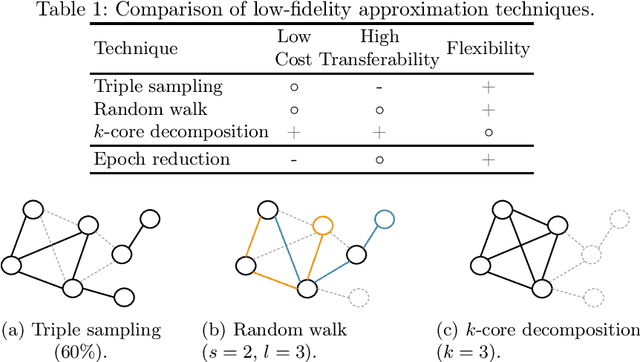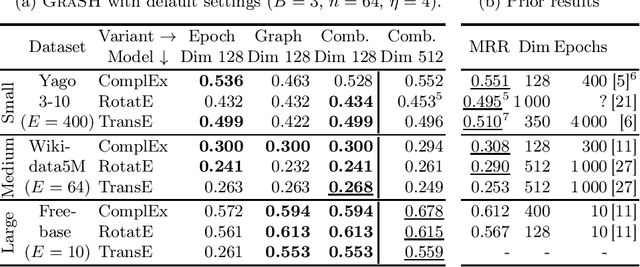Adrian Kochsiek
A Benchmark for Semi-Inductive Link Prediction in Knowledge Graphs
Oct 18, 2023



Abstract:Semi-inductive link prediction (LP) in knowledge graphs (KG) is the task of predicting facts for new, previously unseen entities based on context information. Although new entities can be integrated by retraining the model from scratch in principle, such an approach is infeasible for large-scale KGs, where retraining is expensive and new entities may arise frequently. In this paper, we propose and describe a large-scale benchmark to evaluate semi-inductive LP models. The benchmark is based on and extends Wikidata5M: It provides transductive, k-shot, and 0-shot LP tasks, each varying the available information from (i) only KG structure, to (ii) including textual mentions, and (iii) detailed descriptions of the entities. We report on a small study of recent approaches and found that semi-inductive LP performance is far from transductive performance on long-tail entities throughout all experiments. The benchmark provides a test bed for further research into integrating context and textual information in semi-inductive LP models.
Friendly Neighbors: Contextualized Sequence-to-Sequence Link Prediction
May 22, 2023



Abstract:We propose KGT5-context, a simple sequence-to-sequence model for link prediction (LP) in knowledge graphs (KG). Our work expands on KGT5, a recent LP model that exploits textual features of the KG, has small model size, and is scalable. To reach good predictive performance, however, KGT5 relies on an ensemble with a knowledge graph embedding model, which itself is excessively large and costly to use. In this short paper, we show empirically that adding contextual information - i.e., information about the direct neighborhood of a query vertex - alleviates the need for a separate KGE model to obtain good performance. The resulting KGT5-context model obtains state-of-the-art performance in our experimental study, while at the same time reducing model size significantly.
Start Small, Think Big: On Hyperparameter Optimization for Large-Scale Knowledge Graph Embeddings
Jul 11, 2022



Abstract:Knowledge graph embedding (KGE) models are an effective and popular approach to represent and reason with multi-relational data. Prior studies have shown that KGE models are sensitive to hyperparameter settings, however, and that suitable choices are dataset-dependent. In this paper, we explore hyperparameter optimization (HPO) for very large knowledge graphs, where the cost of evaluating individual hyperparameter configurations is excessive. Prior studies often avoided this cost by using various heuristics; e.g., by training on a subgraph or by using fewer epochs. We systematically discuss and evaluate the quality and cost savings of such heuristics and other low-cost approximation techniques. Based on our findings, we introduce GraSH, an efficient multi-fidelity HPO algorithm for large-scale KGEs that combines both graph and epoch reduction techniques and runs in multiple rounds of increasing fidelities. We conducted an experimental study and found that GraSH obtains state-of-the-art results on large graphs at a low cost (three complete training runs in total).
Sequence-to-Sequence Knowledge Graph Completion and Question Answering
Mar 19, 2022



Abstract:Knowledge graph embedding (KGE) models represent each entity and relation of a knowledge graph (KG) with low-dimensional embedding vectors. These methods have recently been applied to KG link prediction and question answering over incomplete KGs (KGQA). KGEs typically create an embedding for each entity in the graph, which results in large model sizes on real-world graphs with millions of entities. For downstream tasks these atomic entity representations often need to be integrated into a multi stage pipeline, limiting their utility. We show that an off-the-shelf encoder-decoder Transformer model can serve as a scalable and versatile KGE model obtaining state-of-the-art results for KG link prediction and incomplete KG question answering. We achieve this by posing KG link prediction as a sequence-to-sequence task and exchange the triple scoring approach taken by prior KGE methods with autoregressive decoding. Such a simple but powerful method reduces the model size up to 98% compared to conventional KGE models while keeping inference time tractable. After finetuning this model on the task of KGQA over incomplete KGs, our approach outperforms baselines on multiple large-scale datasets without extensive hyperparameter tuning.
 Add to Chrome
Add to Chrome Add to Firefox
Add to Firefox Add to Edge
Add to Edge